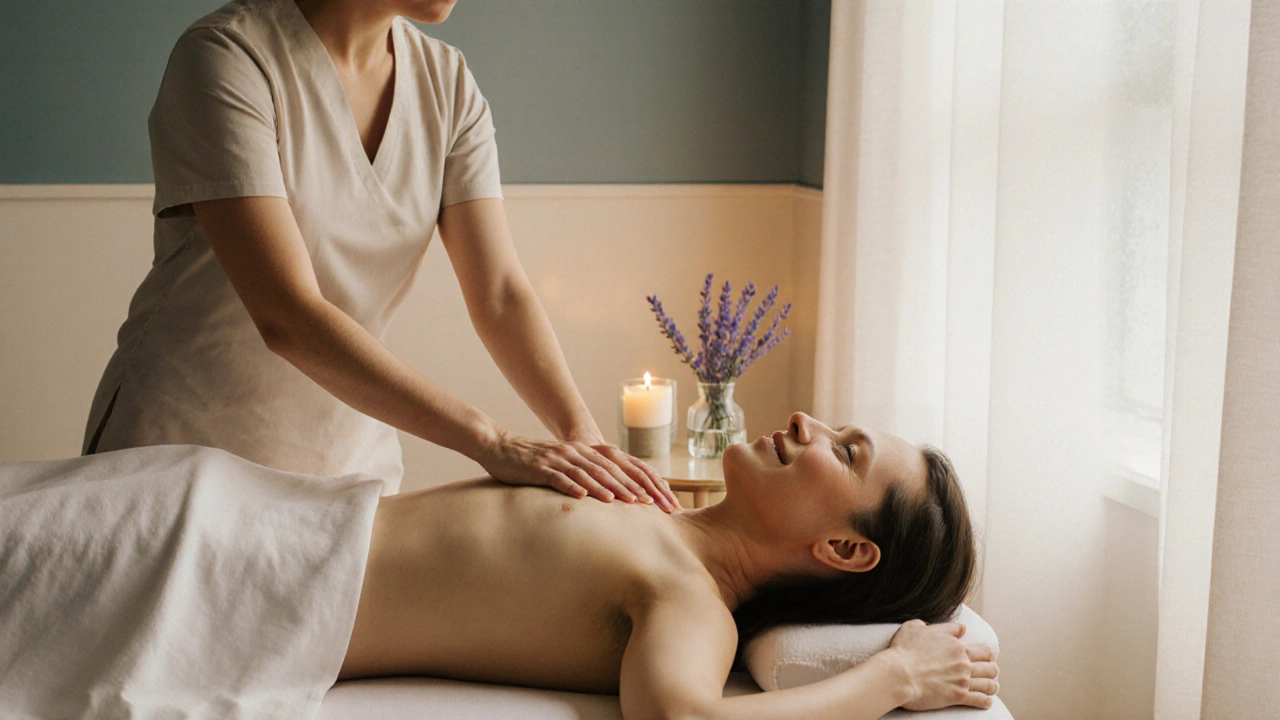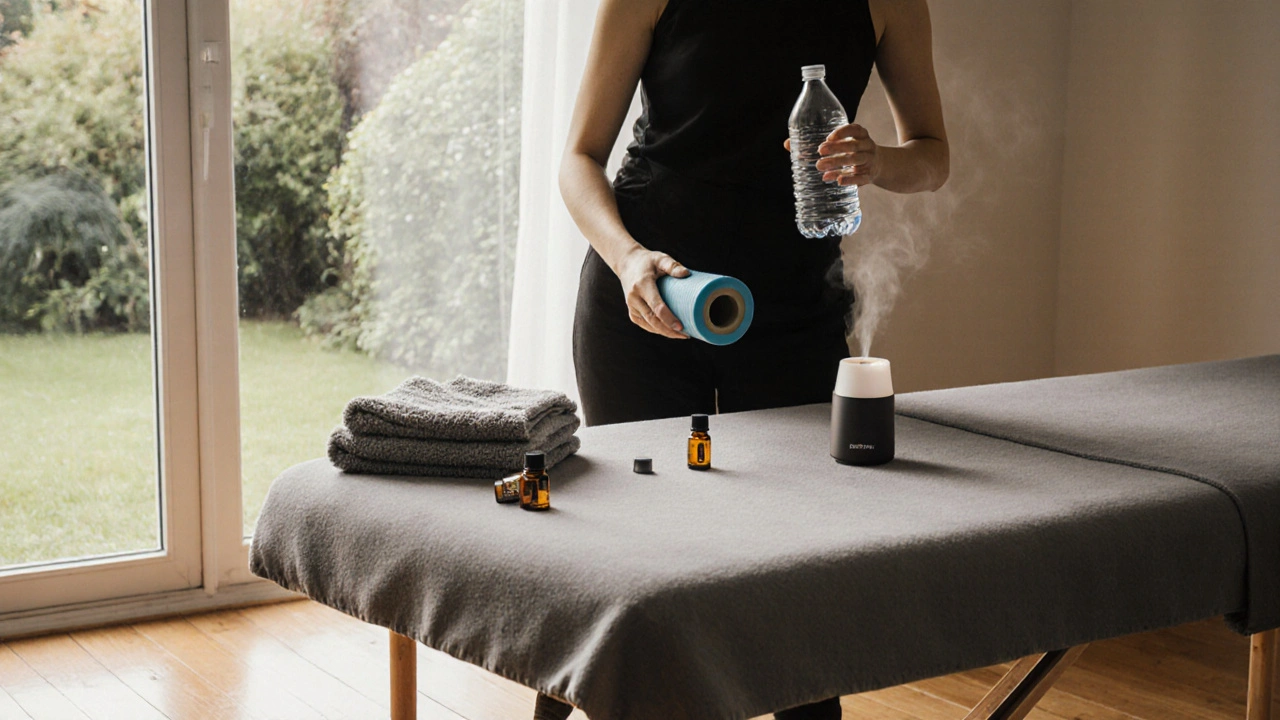Ultimate Guide to Swedish Massage - Benefits, Techniques, and FAQs
 Oct, 26 2025
Oct, 26 2025
If you’re looking for a spa‑style experience that eases tight muscles, boosts circulation, and leaves you feeling totally relaxed, Swedish massage is the go‑to choice. This guide walks you through everything from the basic strokes to the science behind its health perks, so you can decide whether it’s right for you and how to get the most out of each session.
Key Takeaways
- Swedish massage uses long, flowing strokes to improve blood flow and reduce muscle tension.
- It benefits cardiovascular health, the lymphatic system, and mental stress levels.
- Anyone can try it, but people with certain medical conditions should consult a professional first.
- Preparation, communication, and after‑care are essential for a safe, effective session.
- Comparing Swedish massage to deep‑tissue or sports massage helps you pick the right style for your goals.
What Is Swedish Massage?
Swedish Massage is a classic massage technique that focuses on gentle, rhythmic strokes to promote overall relaxation and circulation. Originating in the early 19th‑century Europe, it blends five core strokes-effleurage, petrissage, tapotement, friction, and vibration-to work on superficial muscle layers.
Unlike high‑intensity styles, Swedish massage applies moderate pressure, making it ideal for beginners and anyone looking for stress relief rather than deep muscle manipulation.
Core Techniques and Stroke Types
The five foundational strokes each serve a specific purpose:
- Effleurage: Long, gliding strokes that warm up tissue and enhance blood flow.
- Petrissage: Kneading movements that lift and roll muscles, helping release tension.
- Tapotement: Light tapping or chopping, which stimulates nerves and awakens the nervous system.
- Friction: Deep circular motions that target adhesions and improve tissue flexibility.
- Vibration: Rapid shaking that activates the relaxation response.
Therapists often blend these strokes, adjusting speed and pressure based on client feedback. The goal is to keep the experience fluid, never jolting.
Health Benefits Explained
Research shows that Swedish massage can do more than just make you feel good. A 2022 study in the Journal of Alternative and Complementary Medicine found that regular sessions improved blood circulation by 15 % and lowered cortisol levels, the hormone linked to stress.
Other documented benefits include:
- Enhanced lymphatic drainage: Gentle strokes help the lymphatic system move waste out of tissues, reducing swelling.
- Reduced muscle tension: By loosening tight fibers, the massage diminishes chronic neck, shoulder, and back pain.
- Improved flexibility: The combination of petrissage and friction increases range of motion.
- Boosted mental clarity: The relaxation response triggers endorphin release, sharpening focus after a session.
People with hypertension, arthritis, or anxiety often report measurable symptom relief after a few weeks of consistent treatment.

Who Should Try Swedish Massage?
Swedish massage is widely considered safe for most adults, but certain groups should seek professional advice first:
- Pregnant women: Light pressure is usually fine, but avoid the abdomen and lie on the side.
- Individuals with blood clotting disorders: The increased circulation could dislodge clots.
- People with recent surgeries or fractures: Wait until cleared by a physician.
Otherwise, anyone-from desk‑bound office workers to avid athletes-can benefit. If you’re an athlete, you might combine Swedish massage with a sports massage routine for both recovery and performance.
How to Prepare for a Session
Good preparation maximizes the benefits and ensures a comfortable experience:
- Hydrate the day before-water supports lymphatic flow.
- Avoid heavy meals or alcohol within two hours of the appointment.
- Wear loose, breathable clothing; many studios provide draping sheets.
- Communicate any health concerns, pain points, or pressure preferences.
- Plan a 30‑minute wind‑down after the massage; allow the body to absorb the effects.
Most therapists also ask about aromatherapy preferences. Adding a few drops of lavender oil can deepen relaxation, while peppermint may help with muscle soreness.
DIY Swedish Massage at Home
While professional hands are unbeatable, you can emulate key strokes at home with a few tools:
- Foam roller for effleurage‑like gliding over large muscle groups.
- Massage ball to apply friction on tight spots.
- Handheld massager for gentle tapotement.
Start with 5‑10 minutes of light effleurage on the back and shoulders, then move to petrissage on the calves and thighs. Keep pressure moderate-enough to feel a stretch but not pain. Finish with a few minutes of vibration using the handheld device.

Choosing the Right Therapist
Not all practitioners specialize in the same style. Look for the following credentials when booking a Swedish massage:
- Certification from a recognized school (e.g., NCBTMB or ABMP).
- Specific training in Swedish techniques-some therapists list it on their profile.
- Positive client reviews mentioning relaxation and pain relief.
- Willingness to customize pressure and incorporate aromatherapy or heat therapy if desired.
Don’t hesitate to ask about their approach to pressure points and how they integrate the five core strokes. A good therapist will explain the flow before beginning.
Swedish vs. Other Massage Styles
| Feature | Swedish Massage | Deep‑Tissue Massage | Sports Massage |
|---|---|---|---|
| Primary Goal | Relaxation & general circulation | Targeting deep muscle knots | Performance & recovery |
| Typical Pressure | Light‑to‑moderate | Firm, sustained pressure | Varies; often moderate‑to‑firm |
| Core Strokes | Effleurage, petrissage, tapotement, friction, vibration | Mostly friction & petrissage | Combination of stretching, compression, and tapotement |
| Best For | Stress relief, beginners | Chronic pain, athletes needing intense work | Pre‑/post‑event recovery, injury prevention |
| Typical Session Length | 60 min | 60-90 min | 30-60 min |
If you’re unsure which style aligns with your goals, think about the desired depth of pressure and the primary outcome-relaxation versus targeted muscle work.
Frequently Asked Questions
How often should I get a Swedish massage?
For most people, a monthly session maintains the benefits. If you’re dealing with high stress or chronic tension, bi‑weekly appointments can accelerate relief.
Is Swedish massage safe during pregnancy?
Yes, as long as you avoid deep pressure on the abdomen and lie on your side. Many prenatal massage therapists are trained specifically for safe techniques.
Can I combine Swedish massage with other therapies?
Absolutely. Adding aromatherapy, heat packs, or even a brief session of reflexology can enhance the relaxation response and improve outcomes.
What should I wear to a Swedish massage?
Loose, comfortable clothing is best. Most studios provide sheets to cover you, and you’ll typically undress to your comfort level.
Do I need to tip my therapist?
Tipping is customary in many regions-about 15‑20 % of the session cost-especially if the therapist personalized the treatment to your needs.
Next Steps and Troubleshooting
If you’ve booked your first appointment and feel nervous, remember that communication is key. Tell the therapist about any discomfort immediately; they can adjust pressure or technique on the spot.
After the session, if you experience lingering soreness, try a warm shower, gentle stretching, and extra water intake. Soreness usually fades within 24 hours; persistent pain may indicate you need a lighter pressure setting or a different massage style.
Still have questions? Reach out to a licensed massage therapist in your area or consult reputable sources like the American Massage Therapy Association for more detailed guidelines.
